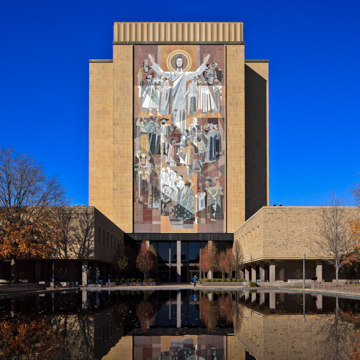You are here
Theodore Hesburgh Library
The Theodore Hesburgh Library, located on the campus of the University of Notre Dame, is an outstanding example of a modern academic library constructed during an era of substantial campus expansion and changing attitudes towards education at the institution. The library also stands as a testament to the achievements of former university president Theodore Hesburgh, who sought to bring Catholic education into the modern age.
Reverend Hesburgh became the president of the University of Notre Dame, a Catholic institution, in 1952. The university was known nationally for the success of its football team, but not for its academic excellence. At the time, the Catholic Church was starting to modernize its practices, culminating with the Second Vatican Council from 1962 to 1965. Many of the other Catholic universities in the United States had largely abandoned their religious focus but Hesburgh had a different vision. He saw Notre Dame both as a modern research institute with high academic standards and a university that still valued Catholic ideals.
Hesburgh pushed for education reforms and implemented new policies that proved to be popular with students and faculty. He eliminated “mass checks” that required students to prove attendance at church services. He also gave faculty more academic freedom and admitted women to Notre Dame’s undergraduate programs starting in 1972. Hesburgh appeared on a cover of Time Magazine in 1962, which claimed that he was the most influential figure reshaping Catholic higher education in the United States.
In 1958, Hesburgh began his “Program for the Future,” which sought to raise millions in donations to construct graduate residence halls, provide student financial aid, and to fund faculty development. The program’s most significant contribution, however, was funding a monumental new library to illustrate the university’s commitment to both academics and Catholic theology. The program’s promotional brochure stated Notre Dame’s intention to become “a Catholic Princeton,” i.e., a nationally ranked university with outstanding academic programs. As part of these fundraising efforts, the new library received a $6 million grant from the Ford Foundation, putting Notre Dame on par with major research institutions like Stanford and Johns Hopkins.
The Ellerbe Company of Minnesota was selected as the architect for the new library project, which was to be named the Memorial Library. The modernist design symbolized Notre Dame’s new approaches towards education. The 13-story “skyscraper library” included a 2-story base and an 11-story tower. It seems that the architects drew inspiration from the great examples of modernism: use of stone similar to Edward Durell Stone’s 1958 Gallery of Modern Art; a “tower on a plinth” form from the 1952 Lever House; and heavy massing similar to Le Corbusier’s late works. The building followed the modernist ideal that form should follow function: the two-story base houses open stacks, meeting rooms, and other student services, while the tower houses the semi-closed stacks, study carrels, and faculty offices. The tower is almost windowless to protect the collection from harmful light, although small windows are concealed in the corners. The space was designed to be open, allowing for flexible use. Luxurious materials were used on the exterior (tweed granite for the base and Mankato stone for the tower), and interior finishes (marble, walnut, and oak paneling) provided a comfortable atmosphere conducive for studying. Biblical symbols, leafed in gold, decorated the exterior and reinforced Notre Dame’s new image of a major university that was centered on Christ’s teachings.
When construction was finished in 1963, the library became part of a new quadrangle dedicated to research. Other buildings included the Radiation Research Building (1963, Skidmore, Owings and Merrill), the Computing Center and Mathematics Building (1962), and the Paul V. Gavin Life Science Center (1967).
Although the library opened in 1963, its landmark Word of Life mosaic mural was not complete until 1964. Hesburgh was inspired by a similar mosaic at the Central Library of the Universidad Nacional Autónoma de México during a visit to Mexico City in 1955. Notre Dame commissioned artist Millard Sheets to design the mural, which was to be placed on the south elevation of the library tower. The imagery depicts the continuity of the Catholic faith through Christian saints, teachers, and writers all below the outspread arms of Christ, the ultimate teacher. The final mosaic measures 134 feet tall and 68 feet wide. The 6,000-7,000 mosaic pieces were affixed to the building via 342 panels. It includes 81 different stones from 16 countries, representing the Catholic Church’s worldwide influence. Since its completion, the mural has gained the nickname of “Touchdown Jesus,” since from the viewpoint of the football stadium, Christ’s arms appear to be blessing the scoreboard.
The Memorial Library was renamed in 1987 to honor Theodore Hesburgh’s contributions to the university.
References
Grubiak, Margaret M. “Visualizing the Modern Catholic University: The Original Intention of “Touchdown Jesus” at the University of Notre Dame.” Material Religion 6, no. 3 (November 2010).
Schmitt, Bill. Words of Life: Celebrating 50 Years of the Hesburgh Library’s Message, Mural, and Meaning. Notre Dame, IN: University of Notre Dame Press, 2013.
Writing Credits
If SAH Archipedia has been useful to you, please consider supporting it.
SAH Archipedia tells the story of the United States through its buildings, landscapes, and cities. This freely available resource empowers the public with authoritative knowledge that deepens their understanding and appreciation of the built environment. But the Society of Architectural Historians, which created SAH Archipedia with University of Virginia Press, needs your support to maintain the high-caliber research, writing, photography, cartography, editing, design, and programming that make SAH Archipedia a trusted online resource available to all who value the history of place, heritage tourism, and learning.






